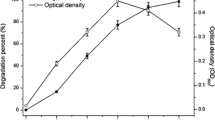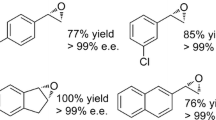Summary
Pseudomonas putida MST, previously isolated in the presence of α-methylstyrene, has been shown to transform several substituted aromatic compounds. It was able to modify halogenated aromatic compounds by co-oxidation. It regiospecifically hydroxylates chlorobenzene and 2-chlorophenol to 3-chlorocatechol, and 4-chlorophenol to 4-chlorocatechol; both metabolites were identified in the cultures.
Similar content being viewed by others

References
Ballschmiter K, Unglert C, Heizmann (1977) Bildung von Chlorphenolen durch mikrobielle Umwandlung von Chlorbenzolen. Angew Chem 89:680–681
Bartels I, Knackmuss HJ, Reineke W (1984) Suicide inactivation of catechol 2,3-dioxygenase from Pseudomonas putida mt-2 by 3-halocatechols. Appl Environ Microbiol 47:500–505
Bestetti G, Galli E, Benigni C, Orsini F, Pelizzoni F (1989) Biotransformation of styrenes by a Pseudomonas putida. Appl Microbiol Biotechnol 30:252–256
Bont JAM de, Vorage AJAW, Hartmans S, Tweel WJJ van den (1986) Microbial degradation of 1,3-dichlorobenzene. Appl Environ Microbiol 52:677–680
Dorn E, Knackmuss HJ (1978) Chemical structure and biodegradability of halogenated aromatic compounds. Two catechol 1,2-dioxygenase from a 3-chlorobenzoate-grown pseudomonad. Biochem J 174:85–94
Gibson DT, Koch JR, Kallio RE (1968a) Oxidative degradation of aromatic hydrocarbons by microorganism. I. Enzymatic formation of catechol from benzene. Biochemistry 7:2653–2662
Gibson DT, Koch JR, Schuld CL, Kallio RE (1968b) Oxidative degradation of aromatic hydrocarbons by microorganism. II. Metabolism of halogenated aromatic hydrocarbons. Biochemistry 7:3795–3802
Gibson DT, Zylstra GJ, Chauhan S (1990) Biotransformations catalyzed by toluene dioxygenase from Pseudomonas putida F1. In: Silver S, Chakrabarty AM, Iglewsky B, Kaplan S (eds) Pseudomonas: biotransformations, pathogenesis, and evolving biotechnology. AMS, Washington, DC, pp 121–132
Gunstone FD (1960) Hydroxylation methods. Adv Org Chem 1:103–147
Haller HD, Finn RK (1979) Biodegradation of 3-chlorobenzoate and formation of black color in the presence and absence of benzoate. Eur J Appl Microbiol Biotechnol 8:191–205
Hammond AL (1972) Chemical pollution: polychlorinated biphenyls. Science 175:155–156
Hartmann J, Reineke W, Knackmuss HJ (1979) Metabolism of 3-chloro-, 4-chloro-, and 3,5-dichlorobenzoate by a pseudomonad. Appl Environ Microbiol 37:421–428
Jackson RW, DeMoss JA (1965) Effects of toluene on Escherichia coli. J Bacteriol 90:1420–1425
Johnston JB, Renganathan V (1987) Production of substituted catechols from substituted benzenes by a Pseudomonas sp. Enzyme Microb Technol 9:706–708
Karns JS, Kilbane JJ, Duttagupta S, Chakrabarty AM (1983) Metabolism of halophenols by 2,4,5-trichlorophenoxyacetic acid-degrading Pseudomonas cepacia. Appl Environ Microbiol 46:1176–1181
Klecka GM, Gibson DT (1981) Inhibition of catechol 2,3-dioxygenase from Pseudomonas putida by 3-chlorocatechol. Appl Environ Microbiol 41:1159–1165
Knuutinen J, Korhoonen IOO (1983) Mass spectra of chlorinated aromatics formed in pulp bleaching. Org Mass Spectrom 18:438–441
Maniatis T, Fritch EF, Sambrook J (1982) Molecular cloning: a laboratory manual. Cold Spring Harbor Laboratory, Cold Spring Harbor, N. Y.
Reineke W, Knackmuss HJ (1984) Microbial metabolism of haloaromatics: isolation and properties of a chlorobenzene-degrading bacterium. Appl Environ Microbiol 47:395–402
Schmidt E, Hellwing M, Knackmuss HJ (1983) Degradation of chlorophenols by a defined mixed microbial community. Appl Environ Microbiol 46:1083–1144
Spain JC, Gibson DT (1988) Oxidation of substituted phenols by Pseudomonas putida F1 and Pseudomonas sp. strain JS6. Appl Environ Microbiol 54:1399–1404
Steiert JG, Crawford RL (1985) Microbial degradation of chlorinated phenols. Trends Biotechnol 3:300–305
Tweel WJJ van den, Bont JAM de, Vorage MJAW, Marsman EH, Tramper J, Koppejan J (1988) Continuous production of cis-1,2-dihydroxycyclohexa-3,5-diene (cis-benzeneglycol) from benzene by a mutant of a benzene-degrading Pseudomonas sp. Enzyme Microb Technol 10:134–142
Wrede F, Muhlroth P (1930) Substitutionsprodukte des Brenzcatechins. Berichte 63:1931–1935
Author information
Authors and Affiliations
Rights and permissions
About this article
Cite this article
Bestetti, G., Galli, E., Leoni, B. et al. Regioselective hydroxylation of chlorobenzene and chlorophenols by a Pseudomonas putida . Appl Microbiol Biotechnol 37, 260–263 (1992). https://doi.org/10.1007/BF00178181
Received:
Accepted:
Issue Date:
DOI: https://doi.org/10.1007/BF00178181



